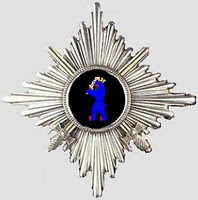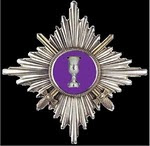Flank Stakes
In one discussion group, folks were speculating on the classic, off-board Flanking Maneuver. The new idea was a strategic, rather than a tactical penetration. In other words, the flanking force would actually never appear on the table, as its target was deeper behind the lines in an effort to drive its foe (I’ll call them the target to keep things simple for my addled pate) completely from the position and to obtain a better battle ground for the decisive engagement.
Since this was the aim of the Colon Coalition in my last game, the question intrigued me a lot. I really wanted to see how Koenig Krieg handled off table movement, but my whole bag containing the rules, dice, and notes is missing (aftermath of the turmoil and turbulence of evicting a “houseguest”).
Now the key to understanding the conundrum here is the simple fact that both such a flanking force and whatever counterforce goes against them WILL NOT BE ON THIS TABLE AT ALL. Indeed, the outcome of the maneuver cannot be effectively known in the scope of a game which recreates the tactical or grand tactical encounter of forces in a specific place to be ideally resolved in one “game day” (or about 4 hours or less of play). While the flanking force and whatever it runs into provides a nice game scenario all in itself, the leading commanders today must fight without knowing how the flanking maneuver turns out. Their primary influence thus will fall into the objectives of the battle commander on that field and in the size and kinds of forces that commander would bring to the battle.
For the flanking player, the obvious choices would be as follows, I think:
a): the size and composition of the flanking force (for gaming purposes, I personally limit the options from 25% to 66 % of the O.B. available to the player);
b): the actual purpose of the strategic flanking maneuver (Is it a raid to say blow up a key bridge or depot? Is it to sieze a key node in the target’s supply line and hold it? Is it to seize a vital objective site to draw the target’s forces onto some sort of kill zone? Etc.): and
c): What is the actual objective now of the force left on the table (make a lot of noise, but run from any real counter offense; attack some point to prevent the target from quickly pulling forces out to meet the flankers; hold the position so that the flanker has to fall back to find another route or be trapped; etc. etc.)?
For the target, however, the situation is much more complex.
First, is the flanking maneuver detected? The determination of this can be a simple die roll modified by commander ratings; or it can be a complex matrix including the quality of scouting and screening forces deployed by each side, the nature of the terrain, who is “at home,” etc. etc. etc. For myself, I prefer very simple solutions.
BUT: if the flanking maneuver IS NOT detected, how to adjudicate “winner” and “loser” of the game, will the target player be allowed to make what sort of provision against the suspected strategic penetration?
IF the target suspects a flanking maneuver, but fails to roll a detection, what can he do? Should he crush the force in front of him and then race back to try to meet the force in his rear? Perhaps the flanking move is purely tactical? Should he hold back a force to deploy to either flank when the off board forces appear? This would obviously weaken the impact of any move made against the enemy on his immediate front. Perhaps, it might even freeze him in place.
On occasion, I’ve deliberately held units off the table on the first move or three simply in order to bring them on in my own rear to strike the target line where it had been weakened to defend against the suspected flanking maneuver (btw, I have consistently misspelled “maneuver” ... thank God for spill chick, eh?). With a “detect flanking force” roll, such a stratagem would be compromised ... as the foe will know they made their roll, yet no flanking force was revealed.
Here’s how I’m thinking of handling the problem.
First of all, both players bring “objectives” to the table, written down before deployment on the table, based on their intelligence of the opponent and what terrain they observe.
Second, tactical flanking forces can not be brought on the table for the first turn or two (there’s a number of systems for deciding when and how tactical flanking forces arrive ... I like simple ones based on the quality of the leadership).
Third, BEFORE DEPLOYMENT, any “detect flanking maneuver” roll should be made ... and this would require some basis ... scouting forces cut from the OB to scout: being on home ground: leadership quality. If the roll is successful, then the other player would need to declare that such a force exists. But this roll would ONLY apply to a strategic flanking maneuver ... in effect saying to the successful caster that some of my forces will not be on today’s table. This would retain the normal value of also including a tactical maneuver!
Fourth, at Turn Three, both players may write down revised objectives for their on board forces ... from “get away alive” to “crush these bozos to let me get at the rest undisturbed”. Then victory points or whatever can be considered in light of the last set of objectives ... and in the difficulty of switching one mode to another in media res ...
Obviously, this needs a whole lot more thought ... and remember I like simple but plausible mechanisms!
Wednesday, March 17, 2010
Subscribe to:
Post Comments (Atom)







3 comments:
Arthur,
I certainly hope that you can find your KK bag. While replacing the dice would be easy, the new rulebook is quite pricey.
An interesting subject, by the way. I will need to have a clear head to consider it more fully (right now I've got a headache).
-- Jeff
Hi Arthur,
It sounds like you are describing the AWI Battles of Long Island and again at Germantown, where the British pinned the Americans in place with troops that threatened frontal attacks, while the real knockout was the flanking force that was ready to roll up the Continental line of battle.
Please keep us posted as you develop this concept of "Grand Tactics".
Martin
Hi Arthur, Tony Bath's book "Setting up a wargames campaign" handled flanking forces with die rolls and a simple table. I haven't got the book with me at the moment but I seem to recall the table was organized according to the respective strengths of the sides.
Post a Comment